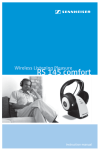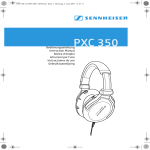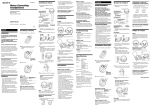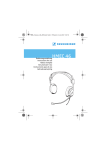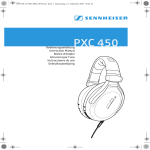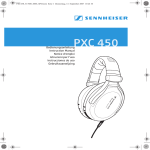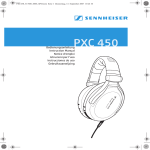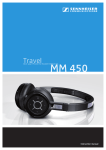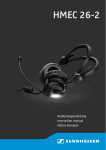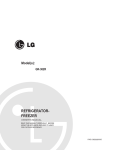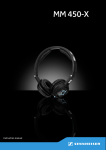Download Sennheiser 250 Headphones User Manual
Transcript
HMEC250_516578_0507_SP6.book Seite 1 Mittwoch, 13. Juni 2007 3:18 15 HMEC 250 Bedienungsanleitung Instruction Manual Notice d‘emploi Istruzioni per l‘uso Instrucciones de uso Gebruiksaanwijzing HMEC250_516578_0507_SP6.book Seite 1 Mittwoch, 13. Juni 2007 3:18 15 Contents Important safety instructions ...................................................2 Delivery includes ..........................................................................4 The HMEC 250 headset ...............................................................5 Operating elements .....................................................................7 LED indications ........................................................................8 Preparing the headset for use ..................................................9 Inserting the batteries .......................................................... 9 Connecting the headset ........................................................ 9 Connecting a mobile telephone ....................................... 10 Connecting an additional audio player ........................... 11 Adjusting the microphone sensitivity ............................ 12 Switching between mono and stereo mode .................. 12 Using the headset .................................................................... 13 Attaching the cable clip ..................................................... 13 Adjusting the headset ....................................................... 13 Adjusting the volume ........................................................ 14 Switching the TalkThrough function on/off .................. 15 Adjusting the volume of the TalkThrough function .... 15 Switching NoiseGard on/off ............................................. 16 Replacing the batteries ..................................................... 17 Folding up the headset ............................................................ 18 Care and maintenance ............................................................. 19 Replacing the earpads ....................................................... 19 Replacing the wind shield ................................................. 20 Accessories and spare parts ................................................... 20 Specifications ............................................................................ 21 Manufacturer declarations ..................................................... 23 1 HMEC250_516578_0507_SP6.book Seite 2 Mittwoch, 13. Juni 2007 3:18 15 Important safety instructions y Please read these instructions carefully and completely before using the headset. y Make these instructions easily accessible to all users at all times. Always include these instructions when passing the headset on to third parties. y During flight operation, do not use the headset for telephone calls. y With the NoiseGard active noise compensation switched on, typical aircraft sounds (for example, those from engines, propellers, warning alarms, etc.) may sound different to you. Before operating any aircraft, make sure that, with NoiseGard switched on, you can hear and recognize these sounds. Set the volume to safe levels that do not interfere with your ability to hear informational sounds and warning alarms. y The headset is capable of producing sound pressure levels exceeding 85 dB(A). In many countries 85 dB(A) is the maximum legally permissible level for continuous noise exposure during the working day. Exposure to sounds of higher volume levels or for longer durations can permanently damage your hearing! y Never repair or attempt to repair a defective headset yourself. Contact your Sennheiser agent or the Sennheiser Service Department. y Only replace those parts of the headset whose replacement is described in this manual. All other parts of the headset must be replaced by your Sennheiser agent. y Protect the headset from humidity. Use only a slightly damp cloth to clean the headset. For information on how to clean the headset, contact your Sennheiser agent. 2 HMEC250_516578_0507_SP6.book Seite 3 Mittwoch, 13. Juni 2007 3:18 15 Safety instructions for batteries If abused or misused, batteries may leak and, in extreme cases, may even present an explosion and fire hazard. Sennheiser does not accept any liability for damage arising from abuse or misuse. Keep batteries out of Observe correct reach and out of polarity. sight of children. Do not heat or throw into fire. Switch off battery powered devices when not in use. Remove batteries when the device is not used for extended periods of time. Dispose of exhausted batteries at special collection points or return them to your specialist dealer. Do not solder. Do not short-circuit. Do not mutilate or dismantle. Do not attempt to recharge non-rechargeable batteries. Do not pack charged batteries loose – danger of shorting out – fire hazard. IAlways remove flat or exhausted batteries from the device immediately. Do not mix old or used batteries with new ones. Do not mix batteries of different types or brands. 3 HMEC250_516578_0507_SP6.book Seite 4 Mittwoch, 13. Juni 2007 3:18 15 Intended use of the headset Intended use includes: y having read these instructions, especially the chapter “Important safety instructions” on page 2, y using the headset within the operating conditions and limitations described in this instruction manual. Improper use means using the headset other than as described in these instructions, or under operating conditions which differ from those described herein. Delivery includes Delivery of the HMEC 250 headset includes: 1 HMEC 250 headset 1 soft case 1 cable clip 2 MZW 46 wind and pop shields 1 audio-in cable for mobile telephones, length 0.6 m, with two 2.5 mm jack plugs 1 audio-in cable for additional audio players, length 0.6 m, with two 3.5 mm jack plugs 2 AAA size batteries 1 instruction manual 4 HMEC250_516578_0507_SP6.book Seite 5 Mittwoch, 13. Juni 2007 3:18 15 The HMEC 250 headset The HMEC 250 headset with NoiseGard 2.0 active noise compensation features closed, dynamic, circumaural stereo headphones. The HMEC 250 is a headset for general aviation use. NoiseGard 2.0 The NoiseGard 2.0 active noise compensation system is based on the principle of cancelling out sound using “antisound” (phase-inverted sound). Tiny microphones pick up low-frequency ambient noise (up to 1 kHz) near the ear. The NoiseGard 2.0 electronics use this noise to generate a sound wave which is the exact opposite (i.e.: at the same level but polarity reversed – 180° out-of-phase), the result is that the polarity reversed signal cancels most of the outside noise. Fail safe operation When the batteries are completely discharged, the NoiseGard 2.0 active noise compensation automatically switches off. RT traffic (e.g. ATC) and intercom will still be heard through the headphones. Peak level protection The peak level protection safeguards your ears from volume peaks above 110 dB. 5 HMEC250_516578_0507_SP6.book Seite 6 Mittwoch, 13. Juni 2007 3:18 15 TalkThrough function The TalkThrough function allows you to communicate with the people around you while wearing the headset. The NoiseGard 2.0 active noise compensation and the peak level protection remain unaffected by the TalkThrough function and help to protect your hearing. Additional features y Outstanding transmission communications quality for clear storage and y Good passive attenuation of ambient noise y Foldable design transportation for space-saving y Noise-compensating boom microphone ensures excellent speech transmission y Flexible microphone boom y Separate left and right channel volume control y Excellent comfort resulting from soft ear pads and headband padding y Audio-input facility for external audio sources, such as mobile phones, MP3 players 6 HMEC250_516578_0507_SP6.book Seite 7 Mittwoch, 13. Juni 2007 3:18 15 Operating elements 햴 쐋 Headset Microphone sensitivity control Headphone cable Microphone boom Earpads Headband Battery compartment (on both sides) Operating control integrated in the cable Cable with microphone plug, 5.25 mm jack plug Cable with headphone plug, ¼” (6.35 mm) jack plug 3.5 mm jack socket for connecting an additional audio player 2.5 mm jack socket for connecting a Operating control integrated in the headset mobile telephone TT VOLUME + button Mono/stereo switch ON/OFF button (NoiseGard 2.0) TT VOLUME – button Separate left and right channel slide volume controls TalkThrough button LED 7 HMEC250_516578_0507_SP6.book Seite 8 Mittwoch, 13. Juni 2007 3:18 15 LED indications 8 Meanings of the LED : LED Meaning red NoiseGard 2.0 operation green TalkThrough operation flashing Batteries are almost flat HMEC250_516578_0507_SP6.book Seite 9 Mittwoch, 13. Juni 2007 3:18 15 Preparing the headset for use Inserting the batteries Insert the batteries into the battery compartments on the left and right earcups as follows: 왘 Open the battery compartment by pushing the catch and open the cover. 왘 Insert the AAA size battery as shown in the diagram on the left. Please observe correct polarity when inserting the battery. 왘 Close the battery compartment . The battery compartment cover locks into place with an audible click. Connecting the headset The headset’s operating control features two cables with one jack plug each. 왘 Connect the headset to the corresponding sockets of your intercom. Connector for connection to the ¼” (6.35 mm) jack plug headphone output 5.25 mm jack plug microphone input 9 HMEC250_516578_0507_SP6.book Seite 10 Mittwoch, 13. Juni 2007 3:18 15 Connecting a mobile telephone The 2.5 mm jack socket allows you to connect a mobile telephone. For this purpose, the microphone plug must be connected to the aircraft radio/intercom. A suitable adapter for your mobile telephone with 2.5 mm jack socket is available from your Sennheiser agent. DANGER! Danger of accident due to reduced attention! Making telephone calls or operating the mobile telephone limits your attention and may cause accidents. 왘 During flight operation, do not use the headset for telephone calls! Note: For the latest list of compatible mobile telephones, please refer to the “Cell Phone Compatibility” section on our website at www.sennheiser.com. Search under “Products”, “Aviation” and “more info …”. 왘 Connect the audio cable to the 2.5 mm jack socket on the operating control and to the corresponding jack socket on your mobile telephone. You can adjust the volume of the mobile telephone via the headset’s operating control. However, the functions of the mobile telephone cannot be controlled via the headset’s operating control. 왘 Switch NoiseGard 2.0 on (see “Switching NoiseGard on/ off” on page 16). Audio from the mobile telephone and from the intercom are heard simultaneously through the headset. 왘 Operate your mobile telephone as usual and observe the manufacturers instructions. 10 HMEC250_516578_0507_SP6.book Seite 11 Mittwoch, 13. Juni 2007 3:18 15 Connecting an additional audio player The 3.5 mm jack socket allows you to connect and listen to an additional audio player (e.g. MP3 player) through the headset. DANGER! Danger of attention! accident due to reduced Listening to music or operating an audio device limits your attention and may cause accidents. 왘 During flight operation, do not use the headset for listening to additional audio sources! Hearing damage due to high volumes! This headset is capable of producing high sound pressure levels. Higher volumes or longer durations can damage your hearing! 왘 Set the volume to a medium level. Make sure that you can hear critical sounds such as warning alarms. 왘 Connect the audio cable to the 3.5 mm jack socket on the operating control and to the corresponding jack socket on your audio player. 왘 Switch NoiseGard 2.0 on (see “Switching NoiseGard on/ off” on page 16). Audio from the additional audio source and from the intercom are heard simultaneously through the headset. 왘 Operate the connected audio player as usual and observe the manufacturers instructions. 11 HMEC250_516578_0507_SP6.book Seite 12 Mittwoch, 13. Juni 2007 3:18 15 Adjusting the microphone sensitivity The microphone sensitivity has been factory pre-set to 40 mV/Pa as per RTCA DO-214. To change the input sensitivity of the microphone: 왘 Use a suitable slotted screwdriver. 왘 Turn the microphone sensitivity control as shown. Switching between mono and stereo mode The mono/stereo switch allows you to switch between mono and stereo mode, depending on the intercom system. 왘 Set the mono/stereo switch to the desired position: – mono – stereo 12 HMEC250_516578_0507_SP6.book Seite 13 Mittwoch, 13. Juni 2007 3:18 15 Using the headset Attaching the cable clip The cable clip allows you to attach the headphone cable to your clothing so that the cable doesn’t hinder or distract you. 왘 Guide the headphone cable through the cable clip . 왘 Attach the cable clip to your clothing. Adjusting the headset 왘 Wear the headset so that – the microphone boom is on the left side of the mouth (see right/left labeling on the headband joints), – the headband runs over the top of your head. 왘 Adjust the length of the headband so that – your ears are completely inside the earpads , – you feel even, gentle pressure around your ears, – a snug fit is ensured. In this way, optimum transmission quality, good noise attenuation and best possible comfort is ensured. 왘 Final adjustment is best made in a noisy environment. 13 HMEC250_516578_0507_SP6.book Seite 14 Mittwoch, 13. Juni 2007 3:18 15 왘 Bend the microphone boom so that the microphone is placed at the corner of the mouth. Maintain a distance of approx. 2 cm between microphone and mouth. Adjusting the volume CAUTION! Hearing damage due to high volume levels! The headset is capable of producing high sound pressure levels. Higher volumes or longer durations can damage your hearing! 왘 Adjust the volume to a medium level. Make sure that you can hear critical sounds such as warning alarms. You can adjust the volume directly on the intercom or via the operating control integrated into the cable. To adjust the volume for the left or right channel: 왘 Slide one of the two volume controls – upwards to increase the volume or – downwards to reduce the volume. 14 HMEC250_516578_0507_SP6.book Seite 15 Mittwoch, 13. Juni 2007 3:18 15 Switching the TalkThrough function on/off The HMEC 250 provides excellent attenuation of ambient noise. In order to allow you to communicate undisturbed with your surroundings while wearing the headset, the HMEC 250 features a TalkThrough function. 왘 Press the TalkThrough button to switch the TalkThrough function on or off. When the TalkThrough function is switched on, the LED lights up green. Adjusting the volume of the TalkThrough function To increase the volume of the TalkThrough function: 햴 왘 Press the TT VOLUME + button. To reduce the volume of the TalkThrough function: 왘 Press the TT VOLUME – button. Note: If you change the volume with the TalkThrough function switched on, the new volume setting is saved and will be used as the default the next time the TalkThrough function is activated. 15 HMEC250_516578_0507_SP6.book Seite 16 Mittwoch, 13. Juni 2007 3:18 15 Switching NoiseGard on/off To switch the NoiseGard™ 2.0 active noise compensation on or off: 왘 Press the ON/OFF button for approx. one second. When NoiseGard 2.0 is switched on: – the LED lights up red and – you can listen to music and make telephone calls at the same time. Fail safe operation When the batteries are completely discharged, the NoiseGard 2.0 active noise compensation automatically switches off. RT traffic (e.g. ATC) and intercom will still be heard through the headphones. 16 HMEC250_516578_0507_SP6.book Seite 17 Mittwoch, 13. Juni 2007 3:18 15 Replacing the batteries When the batteries are almost flat, the LED flashes. When the batteries are completely discharged, the NoiseGard 2.0 active noise compensation automatically switches off (fail safe operation). Replace the battery as follows: Note: Always replace the two batteries at the same time. 왘 Open the battery compartment by pushing the catch and open the cover. 왘 Remove the battery. 왘 Insert a new AAA size battery as shown in the diagram on the left. Please observe correct polarity when inserting the battery. 왘 Close the battery compartment . The battery compartment cover locks into place with an audible click. Note: Remove the batteries from the battery compartments if the headset will not be used for extended periods of time. 17 HMEC250_516578_0507_SP6.book Seite 18 Mittwoch, 13. Juni 2007 3:18 15 Folding up the headset For space-saving transportation, the headset can be folded up in different ways: To fold up the headphones as flat as possible: 왘 Rotate the earcups by 90° and turn the microphone boom flat as shown. To fold up the headphones as compact as possible: 왘 Tuck the earcups between the headband as shown. For safe transportation of the headset, use the supplied soft case and fold the headset as follows: 왘 Rotate the earcups by 90°. 왘 Turn the microphone boom flat as shown. 왘 Pull out the right earcup and then fold it in. 왘 Place the headset flat into the soft case as shown. The two AAA size batteries can be inserted into the two straps at the side of the soft case. The accessories can be transported in the cover of the soft case: – Audio cable (3.5 mm) – Audio cable (2.5 mm) – MZW 46 wind and pop shields 18 HMEC250_516578_0507_SP6.book Seite 19 Mittwoch, 13. Juni 2007 3:18 15 Care and maintenance CAUTION! Liquids can damage the electronics of the headset! Liquids entering the housing of the headset can cause a short-circuit and damage the electronics. 왘 Only use a soft, slightly damp cloth to clean the headset. Do not use any solvents or cleansing agents. 왘 Use a soft, slightly damp cloth to clean the headset from time to time. Replacing the earpads You can replace the earpads. Spare earpads are available as accessories (see “Accessories and spare parts” on page 20). 왘 Grasp the edge of the earpad behind the earcup and peel it up and away from the earcup. 왘 Press the new earpad onto the earcup until it clicks audibly into place. Repeat for the other earcup. 19 HMEC250_516578_0507_SP6.book Seite 20 Mittwoch, 13. Juni 2007 3:18 15 Replacing the wind shield You can replace the wind shield. The HMEC 250 is supplied with a spare wind shield. 왘 Carefully pull the wind shield from the microphone. 왘 Slide-on the new wind shield and ensure that it fits securely over the microphone. Accessories and spare parts Cat. No. Accessories/Spare parts 523889 Earpads (1 pair) 523843 Audio-in cable (3.5 mm), length 0.6 m, 2 x 3.5 mm jack plug 523844 Audio-in cable (2.5 mm), length 0.6 m, 2 x 2.5 mm jack plugs 044740 Cable clip 515297 Wind shield 514127 Wind shield (any number of items) 523897 Headband padding 20 HMEC250_516578_0507_SP6.book Seite 21 Mittwoch, 13. Juni 2007 3:18 15 Specifications General data Weight without cable approx. 285 g Temperature range (operation) -10 to +55 °C Temperature range (storage) -55 to +55 °C Power supply for NoiseGard 2 x 1.5 V AAA size battery or 2 x 1.2 V AAA size rechargeable battery Cable length 1.85 m Headphone connector ¼” (6.35 mm) jack plug Microphone connector 5.25 mm jack plug Additional features NoiseGard on/off TalkThrough on/off TalkThrough Volume +/mono/stereo switch line input mobile telephone input peak level protection fail safe operation Headphones Transducer principle dynamic, closed Ear coupling circumaural Frequency response (headphones) 8–28,000 Hz Frequency response (TalkThrough) 300–5,000 Hz Nominal impedance passive 150 Ω mono 300 Ω stereo Nominal impedance active 600 Ω mono 1,200 Ω stereo 21 HMEC250_516578_0507_SP6.book Seite 22 Mittwoch, 13. Juni 2007 3:18 15 Sound pressure level passive 98 dB at 1 kHz, 1V active 100 db at 1 kHz, 1 V THD at 94 dB SPL <1% Attenuation 13–34 dB passive attenuation, plus 16–25 dB active noise compensation at low frequencies Contact pressure approx. 5 N Microphone incl. preamplifier Type MKE 46 Transducer principle pre-polarized condenser microphone, noise-compensating Frequency response 350–6,000 Hz Output voltage 40 mV/Pa (factory pre-set) = 400 mV at 114 dB SPL (adjustable from 17–100 mV/Pa) Terminating impedance 150–2,200 Ω Supply voltage 8–16 V DC Connector assignment 22 ¼” (6.35 mm) jack plug 5.25 mm jack plug 1 Audio Hi left 2 Audio Hi right 3 Audio Lo 1 not assigned 2 Microphone Hi 3 Microphone Lo HMEC250_516578_0507_SP6.book Seite 23 Mittwoch, 13. Juni 2007 3:18 15 Manufacturer declarations Warranty regulations The guarantee period for this Sennheiser product is 3 years from the date of purchase. Excluded are accessory items, rechargeable or disposable batteries that are delivered with the product; due to their characteristics these products have a shorter service life that is principally dependent on the individual frequency of use. The guarantee period starts from the date of original purchase. For this reason, we recommend that the sales receipt be retained as proof of purchase. Without this proof (which is checked by the responsible Sennheiser service partner) you will not be reimbursed for any repairs that are carried out. Depending on our choice, guarantee service comprises, free of charge, the removal of material and manufacturing defects through repair or replacement of either individual parts or the entire device. Inappropriate usage (e.g. operating faults, mechanical damages, incorrect operating voltage), wear and tear, force majeure and defects which were known at the time of purchase are excluded from guarantee claims. The guarantee is void if the product is manipulated by non-authorised persons or repair stations. In the case of a claim under the terms of this guarantee, send the device, including accessories and sales receipt, to the responsible service partner (www.sennheiser.com). To minimise the risk of transport damage, we recommend that the original packaging is used. Your legal rights against the seller, resulting from the contract of sale, are not affected by this guarantee. The guarantee can be claimed in all countries outside the U.S. provided that no national law limits our terms of guarantee 23 HMEC250_516578_0507_SP6.book Seite 24 Mittwoch, 13. Juni 2007 3:18 15 CE Declaration of Conformity This equipment is in compliance with the essential requirements and other relevant provisions of Directive 89/ 336/EU. The declaration is available on the internet site at www.sennheiser.com. Before putting the device into operation, please observe the respective country-specific regulations! WEEE Declaration Your Sennheiser product was developed and manufactured with highquality materials and components which can be recycled and/or reused. This symbol indicates that electrical and electronic equipment must be disposed of separately from normal waste at the end of its operational lifetime. Please dispose of this product by taking it to your local collection point or recycling centre for such equipment. This will help to protect the environment in which we all live. Batteries The supplied batteries can be recycled. Please dispose of them as special waste or return them to your specialist dealer. In order to protect the environment, only dispose of exhausted batteries. Sennheiser and NoiseGardTM are registered trademarks of Sennheiser electronic GmbH & Co. KG. 24 HMEC250_516578_0507_SP6.book Seite 1 Mittwoch, 13. Juni 2007 3:18 15 Sennheiser electronic GmbH & Co. KG 30900 Wedemark, Germany Phone +49 (5130) 600 0 Fax +49 (5130) 600 300 www.sennheiser.com Printed in China Publ. 06/07 516578/A02





























